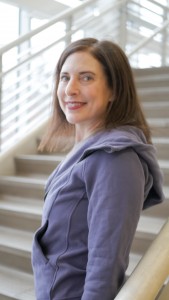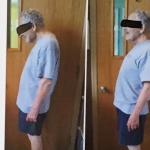September 12, 2018
Gentle Pilates
By Penelope Shore
The Gentle Pilates Internal Alignment Awareness series of exercises that I teach are my way of staying as close to the integrity of the classical Pilates repertoire with the addition of safety modifications necessary when teaching special populations. In my case, special populations begin with people who have been diagnosed with low bone density and are at risk for fracture when doing exercises, or performing activities of daily living, that would not normally cause damage. In Pilates, this is a concern because many of the exercises are in flexion that is loaded with the addition of equipment. My goal is always to teach a fun class or private session where the client leaves feeling terrific, empowered and, above all, safe.
The first thing I do is have the client lie supine in the constructive rest position (CRP). Not only does this feel good, it allows for axial elongation and psoas release and begins the process of learning to feel neutral spine and find neutral pelvis. It allows for them to actually breathe fully. This supine posture takes the stress off the front of the backbone which is at highest risk of stress fracture in instances where bone strength is compromised. This position releases tension in the hip sockets – another area (femoral neck) of greater fracture risk – and allows me to see compensatory movement patterns from sole to spine to crown without the client feeling like they are being “examined”. Watching how a client walks into the room and gets on & off the floor and equipment gives me great insight into their somatic awareness and associated challenges.

Their level of fitness, postural deviations and pain dictate how much I assist the CRP. The rule is that nothing we do should ever hurt and if it does, they must stop immediately and then tell me. We further modify or eliminate as necessary. Kyphotic head postures often need pillows for support. Some clients need to have their hips wedged to help find neutral. I took a yoga block and cut it into small triangles; these work very effectively to help keep hips level. Some people need a small barrel or pillow support under their knees for lower back support. This process is very individual and is a big part of my intro work to find axial elongation and neutral pelvis before we stretch and strengthen.
We want to correct compensatory movement patterns instead of encouraging them. Our bodies want to find ideal alignment, so just these “small” tweaks go very far to facilitate successful movement changes. I often use a super-soft flat foam half-roller to help relax the spine; my clients love this. It is important to watch for postural changes during the session as well. It has been my experience that sometimes after the pelvis has had a chance to release during the first 20 minutes of class that support pillows are no longer necessary to keep the back of the neck in neutral alignment. So, often I remove a pillow and replace with a folded washcloth or nothing if the adjustment is dramatic.
Initially, I explain that our pelvis divides our bodies top and bottom and I show them a model that they pass around. Our spine sits in it (SI joints), our legs hang from it. I equate this to a ceiling in a building, walls build up, chandeliers hang down…. Our bones are the infrastructure in our bodies and if our base (pelvis) is out of alignment, then it throws off the weight distribution throughout the rest of our body. We are then forced to use our muscles, joints and ligaments to do the job our bones are supposed to do which leads to pain and injury. This example usually brings a complete understanding to everyone about the importance of finding and maintaining a neutral pelvis. I explain that this is the difference and why in Pilates we are able to work from the inside out to strengthen, lengthen, tone, find balance and improve.

Quite often, the people who come to me for lessons do not have a definitive understanding of all the functions of their bones. The extra time I spend with the model and simplified descriptions help to de-mystify osteoporosis and empower them. I do my best to answer every question I can, give wellness options that I am aware of, and help as a sounding board. I do not give advice and do not go beyond my scope of practice ever.
The following is a typical sequence I teach in a Gentle Pilates group class. You will note that I spend extra time in CRP and introduce the group to the single leg circle sequence with the addition of the stretch out strap to facilitate full range of motion at the hip socket in a very gentle way.

- Constructive Rest Position
- Pelvic micro-tilts in & out of NP (20X)
- Gentle “Scoop”
- Shoulder Press (3-5X)
- Head Press (3-5X)
- Leg Lengtheners (3-5X)
- Leg Press (3-5X)
- Arm Lengtheners (3-5X)
- Arm & Leg Lengtheners (3-5X)
- Isometric Hundreds in Table Top
- Rib-cage arms with magic circle
- Bridge
- Rib-cage arms with MC / Bridge Combination
- Stretch out strap foot & leg work into Single Leg Circle with end stretch
- Single Leg Stretch
- Double Leg Stretch
- Lower and Lift in Table Top
- Side Kick Series (gentle version)
- Prone – pelvic press, head lift
- Swan
- Spine Release
- Supine, relaxation & nose circles
- Center of Gravity breath, love & gratitude awareness
I teach this to beginners to help them understand and fine tune their Pilates technique. I use it as a foundation for helping people recover from injuries and support alignment in their bodies. I love it as a sequence for people who have osteoporosis. It is very meditative and surprisingly challenging since the exercises do not look like much.
Pilates has never let me down and has often been the only thing in my life I could count on to find personal alignment awareness. When something is wrong in your body, mind, or spirit, go do some Pilates! Seriously, it always helps. It is the fountain of youth that Mr. Pilates said it was and so much more. My hope is that everyone can maintain a personal practice, especially when modifications are necessary, because that will bring the greatest empowerment and ability to transform. Thank you so much!

 Penelope Shure began her Pilates teaching career in 2004 in upstate New York. She teaches specialty workshops which provide continuing education credits for PMA members & private sessions by appointment in her Albany studio. She has been a guest presenter at the Meeks Method Annual conferences in Sundance, Utah, and Baltimore, MD and recently co-taught a course on “Dynamic Movement Solutions” with Sara Meeks, PT in Lenox, MA. Her Gentle Pilates and Gentle Dance videos for bone health have been featured in Margie Bissinger, PT’s “Happy Bones Happy Life” program and on the NBIhealth.com website where Dr. John Neustadt recommended them to his osteoporosis patients. She taught as an adjunct professor for the College of St. Rose in their Physical Education Department in 2017 and is writing a book on how to integrate Pilates as Physical Education into movement education courses. She teaches her Gentle Pilates class weekly at Albany Dance & Fitness.
Penelope Shure began her Pilates teaching career in 2004 in upstate New York. She teaches specialty workshops which provide continuing education credits for PMA members & private sessions by appointment in her Albany studio. She has been a guest presenter at the Meeks Method Annual conferences in Sundance, Utah, and Baltimore, MD and recently co-taught a course on “Dynamic Movement Solutions” with Sara Meeks, PT in Lenox, MA. Her Gentle Pilates and Gentle Dance videos for bone health have been featured in Margie Bissinger, PT’s “Happy Bones Happy Life” program and on the NBIhealth.com website where Dr. John Neustadt recommended them to his osteoporosis patients. She taught as an adjunct professor for the College of St. Rose in their Physical Education Department in 2017 and is writing a book on how to integrate Pilates as Physical Education into movement education courses. She teaches her Gentle Pilates class weekly at Albany Dance & Fitness.
Penelope was born in Syracuse, New York and began training in tap, jazz and ballet at the age of five. She attended Syracuse University, receiving a B.A. in fashion design that brought her to New York City in 1984. There she continued her dance training at Steps & Broadway Dance Center where she was first exposed to Pilates. She taught dance to children and adults and began her formal Pilates training in 1999 while she was busy as a stay at home mom to her two sons, now 20 & 22. In 2004 she completed the Power Pilates NY Intensive certification program and was certified through the Pilates Method Alliance in 2010. She is a Meeks Method osteoporosis exercise specialist and trained extensively through Pilates Therapeutics in foot, scoliosis and performing arts specialization with Dr. Suzanne Martin. She loves working with dancers and people of all ages.
Penelope is a former National Osteoporosis Foundation support group leader and served as a Patient Advocate for “Strong Voices for Strong Bones on Capitol Hill” speaking to NYS elected officials to raise awareness for osteoporosis, bone health & the need to access quality healthcare, bone density testing & increase research funding in 2009. She served on the Eli Lilly & Company’s Mobility Advisory Board in 2009-10 and was a featured bi-monthly blogger for “Better Bones, Holistic Health & Fitness” for the Albany Times Union between 2013-2015.
In her spare time Penelope loves to hike in the Berkshires and take ballet classes. This along with safe Pilates helps her maintain strong bones!

